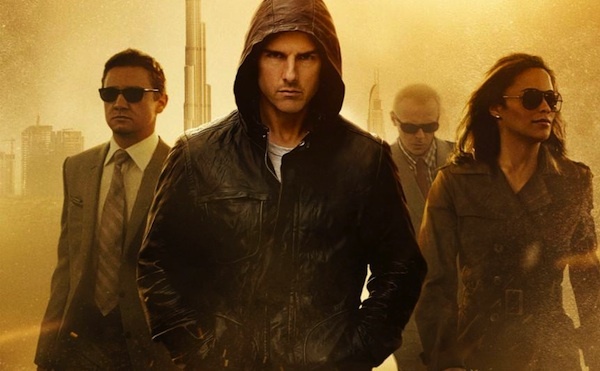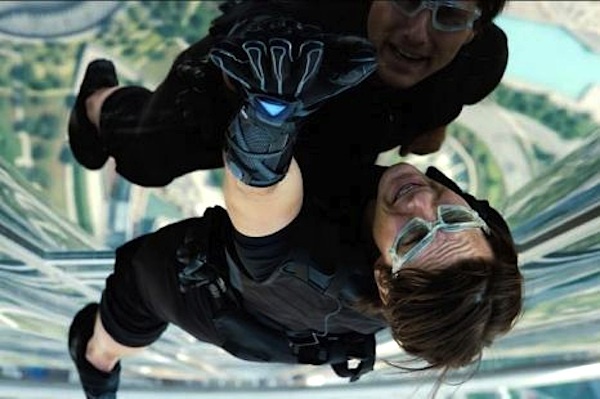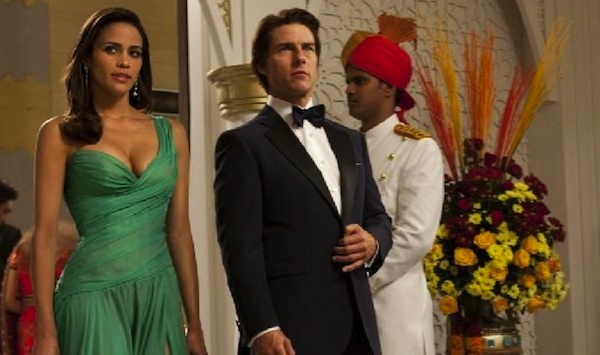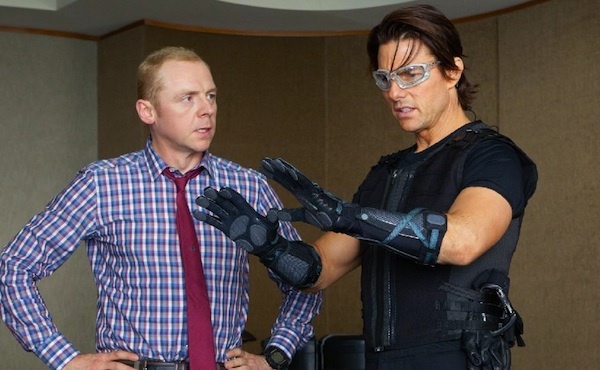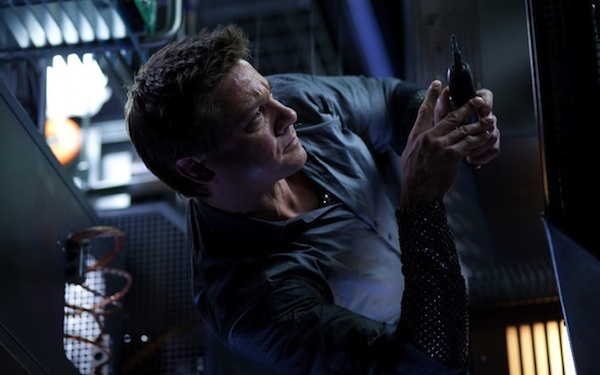The 4th instalment of the spy thriller based on the hit TV show sees aging star Tom Cruise returning to one of his signature roles. Can he still pull off another mission?
Tom Cruise is on the endangered species list.
The last days in the age of the Movie Star are upon us. Here, I’m talking about the traditional Old Hollywood type of star, the kind of screen presence that can lift an entire film. This species might not become completely extinct, but one thing is certain: stars have become all but irrelevant, in terms of their influence on the Box Office. For the last decade or so, industry analysts have seen the trend gradually shift away from the ability of an actor/actress to open a movie, towards a reliance on brand names and franchises (eg: comic book and board game adaptations). It used to be that a star would launch a franchise. Now it’s the franchise that births the star.
Cruise’s career took off in the 80s, Hollywood’s golden age of the action hero. His clean-cut good looks, easy charisma and savvy choices saw his meteoric rise to the A-list, where he excelled at playing archetypes. People don’t give Cruise enough credit as an actor. While it’s true that he has a somewhat limited range, he does extremely well within that range. The bottom line is however, when audiences went to watch Tom Cruise in a movie, that star persona always overshadowed whatever character he was playing. And that was fine. People used to crave a larger-than-life idol fronting any given story.
Times have changed. The era of reality TV, YouTube and social media has eroded the mystique of the Movie Star. Now everyone can be a star. Or at least claim to be. To quote “Jerry Maguire”, we live in a cynical world. In Cruise’s case, he made it easy for us to be cynical about him. The man’s controversial private life and bizarre public behavior seriously affected his Box Office prospects. But apart from the self-inflicted damage, the decline of Cruise reflects the decline of movie stars in general. Today, a name above a film’s title does not guarantee huge audiences anymore. The closest we have to a sure thing is Johnny Depp or Will Smith, but even these guys have had a string of underperforming duds.
It was very clear that Tom Cruise needed “Mission: Impossible” more than the franchise needed him. Despite being actually quite good, Part 3 suffered a drop in earnings because of the stigma associated with him. It still did well enough both critically and commercially to warrant a fourth instalment. Behind the scenes, there were rumblings that Part 4 would be Cruise’s swan song, to make way for new blood. Well, guess what? It seems nobody told director Brad Bird. As far as he’s concerned, he’s made a good old-fashioned spy caper, and for that you need a good old-fashioned Hollywood star.
“Mission: Impossible – Ghost Protocol” is the best entry in the series and easily one of the best action flicks this year. Cruise can take credit for a hearty chunk of the film’s success. For a guy who’s supposedly batshit insane, he sure displays a lot of self-awareness and shrewd business acumen. Serving as producer on this pic, he had a hand in picking the director, and went with a choice some considered unconventional and many considered risky. Cruise knew he had to up the stakes creatively if his career was to see a revival. So he hired a guy who’d never done a live-action project before, and who only had 3 feature films under his belt. All of them cartoons.
Bird has returned the favour, crafting a film that plays to his leading man’s strengths without ever forsaking his own vision. And what a clear, cool vision it is. “Ghost Protocol” is obviously an homage to the spy flicks of yesteryear, complete with wildly imaginative gadgets, glamourous locations, bombastic musical themes, and a good-natured streak of humour throughout. Even the plot is a throwback to simpler times: mad Russian scientist hijacks nukes to spark off global Armageddon. It’s such an outdated idea, it’s gone full circle and become kind of refreshing again. Talk about retro chic.
This is the work of a filmmaker who knows exactly what he’s going for and exactly how to accomplish it. Bird directs with a verve and fearlessness that reminds me of young Spielberg. A little overambitious, but with a solid command of mise en scène (Google it), and a sense of playful inventiveness. Bird, along with his cinematographer Robert Elswit, have done a fantastic job of making the action thrilling without having to resort to the modern-day action director’s crutch of shaky cam. The action is always clear, and we always know where each character is in relation to their location and to the other characters. It’s called spatial geography.
Too many directors nowadays shoot too close and cut too rapidly for the audience to grasp (let alone appreciate) what’s going on — resulting in action scenes that are more confusing than exciting. Bird knows when to move his camera and when to stay put, and it works like a charm. A prime example is the film’s standout sequence, where Cruise’s Agent Ethan Hunt has to scale the world’s tallest building, the Burj Khalifa. Most directors would embellish the heck out of that scene, resorting to multiple angles for maximum coverage, or giving the camerawork a jittery handheld quality to “sell” the fear of heights.
Bird does the complete opposite, locking his camera off into one main angle and slowing the pace of the scene down to a near standstill. What this does is it allows the feeling of vertigo and danger to really sink in. Add to the mix Cruise’s insistence on doing his own stunts, and you have one of the most well-executed action set pieces in recent memory. Bird filmed key scenes like this one in IMAX to really show off the scope, and on that gigantic 3-storey screen, it’s quite a sight to behold. When used right, the IMAX format does add a lot to the viewing experience.
When he’s not exercising admirable discipline and restraint, Bird’s style is pretty lively. It’s no big secret that his background in animation has carried over into his approach towards live-action. “Ghost Protocol” has all the dynamic energy and movement you often find in a Pixar cartoon, like Bird’s own “The Incredibles”. Even the plot barrels along with a strong forward momentum.
Some things get left out though. Perhaps compensating for the rather straightforward story, writers André Nemec and Josh Appelbaum have layered on some extraneous subplots that only end up taking time away from more important stuff like developing the main villain. As it stands, Dr. Kurt Hendricks (played by Michael Nyqvist) isn’t in the movie enough to register as a real threat. He’s more of an elusive shadow, constantly beyond reach. While this is great for moving things along, it does little for us as an audience. A good villain gives us someone to hate and creates dramatic tension. Hendricks does neither.
On the flipside, this particular IMF team is the most fleshed out thus far. The always-watchable Simon Pegg is mostly there for comic relief, but he does it so effectively you just want more of him. The filmmakers are happy to oblige, bumping up his role significantly from the last film. A large part of “Ghost Protocol’s” more fun, lighter tone is due to the laughs Pegg brings. Paula Patton’s character is given the most personal reason to take on this mission, and the outcome of her showdown with a secondary villain is actually more satisfying than Hunt’s final face-off with Hendricks, even though the overall peril is greater in Hunt’s case.
What I like about the way the team is written and portrayed is that they come across as real people. They may be highly-skilled secret agents, but they have believable fears and doubts like you’d imagine any human being would in a high-pressure situation. Jeremy Renner does a memorable turn as an IMF analyst who is riddled with guilt over something in his past and it’s nice to see how it ties in with Cruise’s character at the end. The absence of Hunt’s wife is dealt with in a way that has meaning for both men and also gives Hunt’s story arc a sweet, emotional resolution. Obviously, Bird and the writers want us to care about each member of the team. This is no longer just the Tom Cruise Show.
Which brings us back to the man himself. Audiences may have grown tired of Cruise at some point, but it’s quite hard to imagine anyone begrudging the work he’s done on the “Mission: Impossible” franchise. He has always given it nothing less than his all in every single instalment, regardless of the eventual result (eg: the John Woo cheese-fest “M:I 2”). Whether it’s giving his character nuances not found on the page or putting himself in harm’s way by doing the stunts as extensively as his insurance company will allow, Cruise is one committed performer. The best movie stars usually are.
Brad Bird knows this full well, and there are times in the movie where you can feel the director just sitting back and letting Cruise do his thing. Bird and team made the right call to dial down Cruise’s presence in favour of an ensemble setup. It’s not because he’s being phased out. It’s because the director understands how to use an overexposed movie star like Cruise. Like any precious and dwindling commodity, you want to use it sparingly so it feels special. In other words, less is more.
The showbiz industry may never again see another icon like Tom Cruise. At least, not until the concept of a movie star finds new relevance. And it will, since things happen in cycles. Until then, we have immensely enjoyable experiences like “Mission: Impossible – Ghost Protocol”, made all the more enjoyable by the light of a fading star, still burning brightly for now.
Long live the Movie Star.
For more movie reviews check this out.

